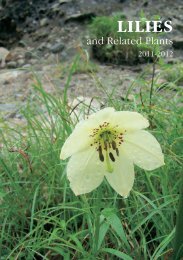LILIES - RHS Lily Group
LILIES - RHS Lily Group
LILIES - RHS Lily Group
Create successful ePaper yourself
Turn your PDF publications into a flip-book with our unique Google optimized e-Paper software.
growing in half shade, so I have now moved my only surviving bulb to the drier<br />
acid bed in full sun, in the hope that it will do better there. With the dryland lily<br />
species, I find that incorporating pine needles together with the ericaceous acid<br />
soil improves the drainage a lot, and also acidifies the soil a bit further, which<br />
some of these lilies like.<br />
I have also tried Lilium columbianum, which, for five years, has only produced<br />
one small leaf per season. This may be because the bulb I purchased was too<br />
young, and simply needs a few years to reach full flowering size.<br />
I think that overall, my climate might be too dry for some of these lilies to be<br />
able to thrive. (The Lilium canadense grown in Geneva Botanical Gardens also<br />
seem to suffer a bit from the very warm and dry summers. It is, after all, a plant<br />
which, in the wild, grows by streams and bogs in North America, where summer<br />
temperatures are rarely as warm as the Swiss ones. Our record in 2005 was 38°C<br />
in August, a summer temperature which is not rare, especially in August, which<br />
is considered the warmest month in Switzerland).<br />
Hybrids<br />
Concerning the hybrids, the asiatic hybrid lilies grow profusely, and spread like<br />
wildfire in my borders. (Four years ago, I purchased a bulb of Lilium ‘Citronella’,<br />
which was a little bit smaller than a golf ball. When I dug it up a few years later,<br />
while I was improving the drainage of my border, it had become the size of a<br />
clenched fist. Lilium ‘Orange Triumph’, an old asiatic hybrid similar to Lilium<br />
bulbiferum, needs excellent drainage to do well, flowering in early June with<br />
gleaming orange, slightly scented flowers, opening from hairy buds.<br />
The North Hybrid lilies, although becoming rarer to find, do very well overall,<br />
with hybrids such as ‘Eros’, ‘Bronwen North’, ‘Angela North’ as well as some<br />
unidentified orange and cream North Hybrids flowering profusely in June and<br />
July, often producing over 20 flowers per stem.<br />
I also grow oriental hybrids such as ‘Stargazer’ (one of my favourite lilies) and<br />
‘Casablanca’ as well as some recent OTs such as ‘Faros’, ‘Conca d’Or’ and ‘Yellow<br />
Stargazer’. However, I find that many of the oriental hybrids start declining after<br />
a few years, and can be very sensitive to rotting. In recent years, they have also<br />
started flowering much earlier, in late June and July, instead of in August as they<br />
used to do. An interesting anecdote about ‘Yellow Stargazer’ is that after having<br />
flowered profusely in June, it all of a sudden started growing a new shoot at the<br />
end of August. Hopefully this new stem will flower before the first frosts!<br />
Concerning the trumpet hybrids, these grow very profusely, and<br />
make huge bulbs in time. They have also broken the records amongst my lilies in<br />
all categories, with one stem of ‘Royal Gold’ producing 25 flowers, and another<br />
stem reaching 206 cm.<br />
66




